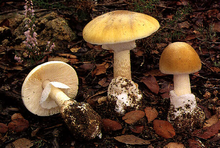Talk:Amanita citrina
Amanita citrina (synonym Amanita mappa), commonly known as the false death cap or citron amanita, is a basidiomycotic mushroom, one of many in the genus Amanita. It grows in silicate soil in the summer and autumn months. It bears a pale yellow or sometimes white cap,
with white stem, ring and volva. Though not deadly, it is inedible and often confused for the lethal death cap (Amanita phalloides).
By dry weight, it contains 0.8% bufotenin in the caps, 1.5% in the stripes and 0.065% in the bulbs [1]
Toxicity and harm potential

It is important to convert ibotenic acid to muscimol before consumption.
Please read Fly agaric: Ibotenic acid decarboxylation to muscimol to learn how to convert the relatively neurotoxic compound (speculated to be a stimulant[2][3]) ibotenic acid to muscimol.
Also, novel edibles "Amanita Mushroom Gummies" contain a substantial amount of ibotenic acid along with muscimol and muscarine. Given the toxicity of ibotenic acid, the consumption of those preparations even in small doses should be avoided![4]
A 1998 publication listed Muscimol as an Extremely Hazardous Substance (EHS) on the Environmental Protection Agency's (EPA) list. However, a later document from 2006 shows it was removed from the list.
Physical appearance
This mushroom has a fleshy pale yellow, or sometimes white, cap from 4–10 cm (1.5–4 in) across, covered in irregular patches. The gills and flesh are white. There is a large volva at the base of the 6–8 cm (2.5–3 in) tall stem, which has a clear ring. It is often confused with the related death cap mushroom (Amanita phalloides), hence the name.
Similar species

Hunting psychoactive mushrooms in nature can be very dangerous.
Caution is advised because poisonous or deadly mushrooms can easily be mistaken for edible ones.
 Amanita phalloides - Deadly - This species contains α-amanitin and β-Amanitin which has lead to numerous deaths. |
Legal status
Unless bufotenin is specified by law to be illegal, this mushroom isn't prohibited. Due to not containing muscimol, it is not classified under most legal codes as a psychoactive amanita species.
- Australia - Bufotenin is classified as a Schedule I controlled substance according to the Criminal Code Regulations of the Government of the Commonwealth of Australia. It is also listed as a Schedule 9 substance under the Poisons Standard (October 2015). A schedule 9 drug is outlined in the Poisons Act 1964 as "Substances which may be abused or misused, the manufacture, possession, sale or use of which should be prohibited by law except when required for medical or scientific research, or for analytical, teaching or training purposes with approval of the CEO." Under the Misuse of Drugs Act 1981 6.0 grams (0.21 oz) is determined to be enough for court of trial and 2.0 grams (0.071 oz) is considered intent to sell and supply.
- The United Kingdom - In the United Kingdom, bufotenin is a Class A drug under the 1971 Misuse of Drugs Act.[5]
- United States - Bufotenin (DEA Drug Code 7403) is regulated as a Schedule I drug by the Drug Enforcement Administration at the federal level in the United States and is therefore illegal to buy, possess, and sell.[6]
- ↑ https://www.samorini.it/doc1/sam/fallit.htm
- ↑ Chilton 1975; Theobald et al. 1968
- ↑ Chilton 1975; Ott 1976a
- ↑ https://www.kykeonanalytics.com/news/New-trend-of-Amanita-Mushroom-Gummies-potentially-neurotoxic-edibles/
- ↑ https://en.wikipedia.org/wiki/Misuse_of_Drugs_Act_1971
- ↑ https://web.archive.org/web/20090827043725/http://www.deadiversion.usdoj.gov/21cfr/cfr/1308/1308_11.htm
